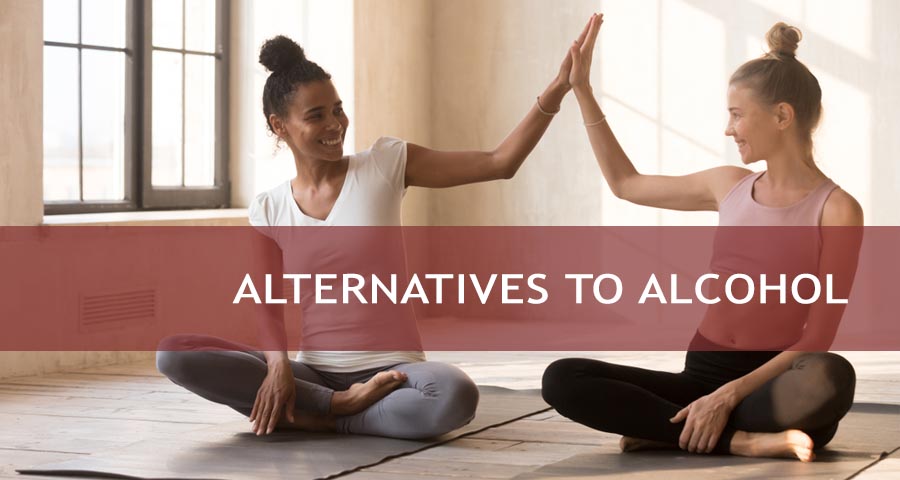Choosing Safe Alcohol Alternatives for a Sober Life

In recent years, there has been a growing trend toward healthier lifestyles, encouraging people to reconsider what they eat and drink.
This mindset change has been significant for those recovering from alcohol use disorder. In fact, alcohol alternatives have become very popular, with non-alcoholic beverage sales reaching a record of half a billion dollars as of July 2023.
With more people choosing to live an alcohol-free life, you may be curious about where to start. This article is a great place to inform yourself about a starting point. Whether you’re taking a temporary break from alcohol or making a permanent decision, continue reading to discover alcohol-free alternatives, their advantages, and where to find them.
Table Of Contents:
What are Alcohol-Free Alternatives?
As the name suggests, non-alcoholic beverages are alcohol-free drinks created to substitute alcoholic drinks and to counteract the health risks caused by excessive alcohol consumption safely.
The World Health Organization (WHO) has encouraged the alcohol industry to reduce alcohol content in its products. This strategy helps in temporary abstinence and potentially reduces excessive alcohol intake, playing a crucial role in reducing alcohol consumption among heavy drinkers.
Types of Free Alcohol Alternatives
Non-alcoholic beverages can be classified into two main categories based on their alcohol content:
Alcohol-Free Beverages
These beverages are entirely free of ethanol, the chemical compound responsible for the intoxicating effects of alcoholic drinks. Zero-alcohol drinks are the only safe option instead of alcohol for those recovering from alcohol use disorder and those who don’t drink due to health reasons or religious beliefs. Thus, they are considered as an alcohol substitute.
Zero-alcohol drinks can be:
- Fruit juices
- Soft drinks (smoothies, milkshakes)
- Herbal teas
- Alcohol-free beers and wines
Low-Alcohol or Reduced-Alcohol Beverages
These types of drinks contain a significantly lower alcohol content compared to their alcoholic counterparts.
These drinks are processed to remove or reduce their alcohol level, often resulting in a drink with less than 0.5% alcohol by volume (ABV). It’s important to keep this percentage in mind as research shows that any drink with less than 0.5% vol. may not raise blood alcohol levels, impair driving abilities, and is considered a virtually safe dose.
However, since marketing can be misleading, don’t fully trust products marketed as “free,” “zero,” “low,” or “light.” Always read the ingredients label!
Low-alcohol or reduced-alcohol may include:
- Some non-alcoholic beers, wines, gin, that mimic the taste and aroma of traditional alcoholic drinks
Free of Alcohol Alternatives
An almost infinite variety of zero-alcohol drinks are fit to satisfy all types of preferences and palates. The types of alcohol-free beverages are:
- Mocktails: Alcohol-free drinks crafted to mimic the taste and presentation of traditional cocktails
- Alcohol-free beers are brewed like traditional beers but undergo a process to remove the alcohol
- Non-alcoholic wines underwent de-alcoholization processes to remove or reduce alcohol content
- Kombucha is made by fermenting tea with a symbiotic culture of bacteria and yeast (SCOBY)
- Other alcohol-free options include iced teas, cold brew coffee, and matcha lattes
Below, you can find a chart with great alcohol-free alternatives with their respective ingredients for you to have them at the bar or the grocery store or maybe to make them at home:
| Free of Alcohol Alternatives | Ingredients |
|---|---|
| Sparkling Citrus Cooler | Freshly squeezed orange juice, lemon juice, honey/agave syrup, sparkling water, ice cubes, lemon or orange slices for garnish |
| Minty Watermelon Refresher | Fresh watermelon, fresh mint leaves, lime juice, simple syrup (optional), sparkling water, ice cubes |
| Berry Basil Smash | Mixed berries (e.g., strawberries, raspberries), fresh basil leaves, lime juice, simple syrup (optional), soda water, ice cubes |
| Cucumber Cooler | Fresh cucumber, lime juice, simple syrup (optional), soda water, ice cubes, cucumber slices for garnish |
| Pineapple Ginger Mocktail | Fresh pineapple juice, ginger syrup, lime juice, soda water, ice cubes, pineapple wedge for garnish |
| Lavender Lemonade | Freshly squeezed lemon juice, lavender syrup, water, ice cubes, lemon slices for garnish |
| Coconut Lime Refresher | Coconut water, lime juice, simple syrup (optional), soda water, ice cubes, lime wedge for garnish |
| Kombucha Spritzer | Kombucha, soda water, fresh fruit slices (e.g., lemon, lime, berries), ice cubes |
| Alcohol-Free Beer | Malt extract, hops, yeast, water (fermented and dealcoholized), flavorings (optional) |
| Iced Rooibos Tea | Rooibos tea bags, water, lemon slices, honey or agave syrup (optional), ice cubes |
| Cold Brew Coffee | Coarsely ground coffee beans, cold water, optional flavorings (e.g., vanilla, cinnamon) |
| Matcha Latte | Matcha powder, hot water, steamed milk (or alternative milk), sweetener (optional) |
10 Practical Tips to Reduce Alcohol Intake
Alcohol consumption is linked with over 200 health conditions and is among the top five risk factors for disease in the world.
The following list outlines the diseases and injuries caused by high alcohol consumption:
- Infectious disease
- Cancer
- Diabetes
- Neuropsychiatric disease
- Cardiovascular disease
- Liver and pancreas disease
- Unintentional and intentional injury
Reduction in alcohol intake not only works for those recovering from alcohol dependence but also reduces the probability of developing chronic diseases.
To reduce your alcohol intake, here are some practical tips to help you out:
- Define achievable goals for reducing your alcohol consumption (i.e., fewer days per week)
- Keep a journal or use a tracking app to monitor how much alcohol you consume
- Set boundaries for yourself and stick to them (i.e., only drinking on special occasions)
- Try our alcohol alternatives like mocktails, sparkling water, herbal teas or alcohol-free beers and wine
- Pay attention to your thoughts and feelings when you drink alcohol
- Use these feelings to identify triggers that may lead to excessive drinking (i.e., stress, anxiety)
- Find healthy ways to cope with stress and manage emotions without relying on alcohol
- Find peer support for motivation on your journey to reduce alcohol intake or maintain sobriety
- Bring your non-alcoholic beverages for social events and have an exit strategy if you feel uncomfortable
- If you feel tempted to relapse or suspect of alcohol dependence, seek professional as soon as possible
Alcohol Alternatives − Final Considerations
Alcohol alternatives to relax can be a multipurpose option for health and wellness. These beverages not only help to maintain sobriety or reduce the health risks associated with alcohol consumption but also provide numerous benefits as they are often made from natural ingredients.
If you choose to drink, follow the U.S. Dietary Guidelines and limit alcohol intake to one drink or less per day for women and two drinks or less per day for men. If you are pregnant or trying to conceive, avoid alcohol entirely. Alcohol causes fetal alcohol spectrum disorders (FASDs) and increases the risk of preterm labor. Underage drinking is strongly discouraged, too.
If you or someone you know struggles with alcohol consumption, seek professional assistance quickly for support and guidance.
People Also Ask
What are non-alcoholic beverages?
Non-alcoholic beverages are drinks that do not contain alcohol. Examples include fruit juices, soft drinks, herbal teas, sparkling water, mocktails (alcohol-free cocktails), and non-alcoholic beers and wines. These beverages offer a variety of flavors and can be enjoyed without the effects of alcohol.
What to replace alcohol with?
Non-alcoholic beverages like mocktails, herbal teas, and sparkling water provide enjoyable alternatives. Engaging in activities such as yoga, hiking, or cooking can offer relaxation and socialization without the need for alcohol.
What can give you a buzz besides alcohol?
Activities such as intense workouts, engaging conversations, adrenaline-inducing experiences like roller coasters, or even certain foods like spicy dishes can stimulate the release of endorphins, giving you a natural “buzz” or euphoria.
Hope Without Commitment
Find the best treatment options. Call our free and confidential helpline
Most private insurances accepted
Page Sources
- Torres, C. (2023, December 22). Bars offering non-alcoholic drinks are growing in popularity across the country. Fox Business. https://www.foxbusiness.com/fox-news-food-drink/bars-offering-non-alcoholic-drinks-growing-popularity-across-country
- Yoshimoto, H., Kawaida, K., Dobashi, S., Saito, G., & Owaki, Y. (2023). Effect of provision of non-alcoholic beverages on alcohol consumption: a randomized controlled study. BMC Medicine, 21(1). https://doi.org/10.1186/s12916-023-03085-1
- Okaru, A. O., & Lachenmeier, D. W. (2022). Defining No and Low (NoLo) Alcohol Products. Nutrients, 14(18). https://doi.org/10.3390/nu14183873
- Harrison, K., & Curtin, C. (2021). Microbial Composition of SCOBY Starter Cultures Used by Commercial Kombucha Brewers in North America. Microorganisms, 9(5). https://doi.org/10.3390/microorganisms9051060
- M. Blackwell, A. K., Hollands, G. J., Morris, R. W., Brocklebank, L. A., Maynard, O. M., Fletcher, P. C., Marteau, T. M., & Munafò, M. R. (2020). The impact on selection of non-alcoholic vs alcoholic drink availability: An online experiment. BMC Public Health, 20. https://doi.org/10.1186/s12889-020-08633-5
- Rehm, J. (2011). The Risks Associated With Alcohol Use and Alcoholism. Alcohol Research & Health, 34(2), 135-143. https://www.ncbi.nlm.nih.gov/pmc/articles/PMC3307043/
- Alcohol use during pregnancy. (2023, October 3). Centers for Disease Control and Prevention. https://www.cdc.gov/ncbddd/fasd/alcohol-use.html

 Authored by
Authored by  Reviewed by
Reviewed by 



